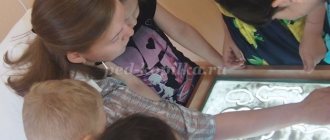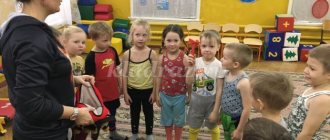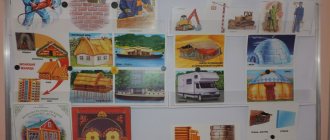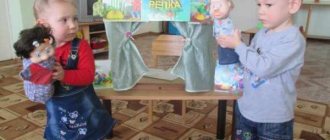Summary of a lesson with children 2–3 years old based on the fairy tale “Kolobok”
Summary of a lesson with children 2–3 years old based on the fairy tale “Kolobok”
Goal: developing interest in oral folk art.
Tasks :
- develop children’s speech, the ability to pronounce simple oral forms following the example of an adult;
- enrich children's vocabulary;
- cultivate empathy, a desire to help the heroes of the fairy tale.
Vocabulary work: bun - ruddy side, bunny - jumping, gray wolf, clumsy bear, cunning fox.
Materials: toys - bun, hare, wolf, bear, fox; basket with carrots, clothespins, Christmas trees.
Progress of the lesson:
Children are included in the group. They sit on the chairs.
Educator: A fairy tale is coming to visit. The hero lives in that fairy tale. He left his grandmother, he left his grandfather, rolled, ran, and got on the fox’s tongue. Who is this? (kolobok)
Educator: Guys, grandma kneaded the dough and made the bun. Let’s try to make Kolobok too. Get your hands ready.
Finger gymnastics “Quickly knead the dough”
We quickly kneaded the dough (open and close our palms) divided it into pieces (simulate pinching) rolled out all the pieces (rub palm to palm) and formed little balls (show two fists)
Educator: Guys, look at my Kolobok. Guys, the bun is calling us to his fairy tale. Let's go to?
Children get up from their chairs and follow the teacher. The teacher sings for the kolobok: I am the kolobok, I am the ruddy side of the kolobok.
Educator: Guys, look whose ears are sticking out from behind the Christmas tree? Who is this? (Hare. Bunny is a hopper. Children say it together with the teacher.
The teacher puts the bunny toy on his hand and says for the bunny: kolobok, kolobok, I will eat you! Kolobok: Don’t eat me, I’ll treat you to carrots. He takes a basket of carrots and accidentally spills them. Kolobok: Guys, help the hare collect carrots.
There is an active game going on: “collect the carrots.”
Kolobok: Guys, thank you for helping me collect carrots for the hare. Goodbye, Bunny!
Kolobok: Let's move on. I am a bun, a bun, I am a ruddy side. Guys, look whose nose is sticking out from behind the Christmas tree? Who is this? (Wolf. Gray wolf).
The teacher puts a wolf toy on his hand and says for the wolf: I am an angry, hungry wolf. I'm covered in thorns. Kolobok, Kolobok, I will eat you! Kolobok: Don't eat me. Guys, let's help the wolf, remove the thorns.
A sedentary game is underway: we remove the clothespins from the wolf.
Wolf: Thank you guys, I won’t eat the kolobok. Goodbye!
Kolobok: Let's move on. I am a bun, a bun, I am a ruddy side.
Guys, look who climbed up the Christmas tree? (Bear. Teddy Bear).
The teacher puts the bear toy on his hand and says for the bear: Kolobok, Kolobok, I will eat you! Kolobok: Don’t eat me, the guys and I will tell you a poem. The children, together with the teacher, recite the verse, and, in accordance with the verse, make movements: A clubfooted bear walks through the forest, collects cones and puts them in his pocket. The cone bounced right into the bear's forehead. Mishka became as angry as a foot. Bear: thanks guys, I won’t eat the kolobok. Goodbye!
Kolobok: Let's move on. I am a bun, a bun, I am a ruddy side.
Guys, whose red tail is that peeking out from behind the Christmas tree? Who is this? (Fox. Sly little fox).
The teacher puts a fox toy on his hand and says for the fox: Kolobok, Kolobok, I will eat you! Kolobok: Don’t eat me, the guys and I will dance for you. Children with a teacher dance to Russian folk music. Lisa: thank you guys, and for making me laugh,
Kolobok: Guys, let's say goodbye to the fox.
Kolobok: And now we are returning to kindergarten.
The teacher and children move back to the chairs.
Educator Guys, did you like the fairy tale? What is the name of our hero? (kolobok). What did we treat the hare to? (carrot). Who did we remove the thorns from? (from a wolf). Who did we dance with? (with a fox).
Educator: on behalf of Kolobok: Thank you guys for your help in my fairy tale. I want to treat you to bagels, they are made from dough, just like me!
Thank you Kolobok (the children thank Kolobok)
Let's wave goodbye to the bun. Kolobok, come visit us again.
Kolobok. Lesson on fiction Russian folk tale
Date:__________________________ Fiction. Topic: “Kolobok” Russian folk tale. Program content: 1. To consolidate familiar fairy tales in children’s memory, recognize them by fragments, illustrations, objects, etc. 2. Develop thinking, memory, imagination. 3.Cultivate interest and love for fairy tales. 4. Literacy - continue to work on the sentence, its verbal composition, analyze, write them down schematically. 5. Formation of the skill of coordinating hand movements when writing. 6. Develop eye and fine motor skills. Equipment: Illustrations for fairy tales - “The Wolf and the Seven Little Goats”, “The Ryaba Hen”, “The Little Fox-Sister and the Gray Wolf”; exhibition of books on fairy tales; ball; toys - hare, fox, bear, wolf, bun; notebooks; a yellow pencil for each child; Progress of the lesson 1. Organizational moment, announcement of the topic: - Guys, do you like fairy tales? (Yes.) You already know a lot of fairy tales. And today we have gathered to once again remember our favorite fairy tales, to find out which of you knows more fairy tales. So, the journey to the land of fairy tales begins! Reading the poem by F. Krivin “The floorboard is creaking about something”: The floorboard is creaking about something, And the knitting needle can’t sleep again, Sitting down on the bed, the pillows Already perked up their ears. And immediately the faces change, the sounds and colors change... The floorboard creaks quietly, a fairy tale walks around the room... The game: “You give me - I give you.” (Children stand in a circle. The leader from the middle of the circle throws the ball to the children, naming the animal. Children take turns answering in which fairy tale this hero appears.) For example: cow - fairy tale “Kroshechka - Khavroshechka.” Goat -…; Bear -…; Wolf -…; Geese -…; Fox -…; Chicken -…; Hare -... Well done! - We quietly sit down at the table. 2. Main part: - Fairy tales tell about the unprecedented, the miraculous, and they come in different forms: folk and original. — Guys, why do you think fairy tales are called folk tales (because they were composed by the people). Fairy tales were passed from one person to another. Therefore, fairy tales belong to oral folk art. — Why are fairy tales called author’s fairy tales? (because they were composed and written by one person - the author). Fairy tales are good. In every fairy tale...(good) always wins, and evil always...(is punished). Game: “Find out a fairy tale from a riddle” - Guys, do you know a lot of fairy tales? (Yes). Let's check it now. I will ask you riddles, and you will name a fairy tale. ** A girl appeared in the cup of a flower, And that girl was a little larger than a marigold. (Thumbelina) **Near the forest, on the edge, Three of them live in a hut. There are three chairs and three mugs, three beds, three pillows. Guess without a hint, who are the heroes of this fairy tale? (Three Bears) **He treats small children, Heals birds and animals, The Good Doctor looks through his glasses... (Aibolit). Game: “Recognize the fairy tale from the picture” - Well done, you can recognize the fairy tale from the riddle. And try to recognize the fairy tale from the illustration (on the board there are illustrations for the fairy tales “The Wolf and the Seven Little Goats”, “The Rock Hen”, “The Little Fox-Sister and the Gray Wolf”). 1) - Guys, look and tell me what fairy tale this illustration is from? — shows an illustration from the fairy tale “The Wolf and the Seven Little Goats” (This is the fairy tale “The Wolf and the Seven Little Kids.”) — Who composed it? (This is a Russian folk tale.) - Guys, “The Wolf and the Seven Little Goats” is a German fairy tale, a fairy tale by the Brothers Grimm. It became widespread in Russia, became part of oral folk art and, with some changes in the plot, received the status of a “Russian folk tale.” - What does this fairy tale teach us? (Because you can’t open the door for strangers, listen to your mother, don’t be evil like a wolf, but you have to be kind.) 2) - Look and tell me which fairy tale this illustration is from? — shows an illustration from the fairy tale “Ryaba Hen” (This is the fairy tale “Ryaba Hen.”) — Which chicken in this fairy tale is good or bad? (The chicken is good. She gave her grandfather and grandmother a golden egg, and when the mouse broke it, she took pity on them and laid another egg for them.) Game: “Recognize the fairy tale by the heroes” - I will name the fairy-tale heroes, and you will remember the names of the fairy tales, in which they act. 1. Grandfather, bug, granddaughter, mouse. (Fairy tale “Turnip”) 2. Mouse, grandmother, egg. (Fairy tale “Rocktail Hen”) 3. A very little girl, a cockchafer, a swallow, a mouse. (Fairy tale “Thumbelina”) 4. Tsar, three sons, arrow, swamp. (Fairy tale “The Frog Princess”) Guess the riddle: It is shaped like a ball. He was once hot. He jumped off the table onto the floor and left his grandmother. He has a ruddy side... Did you recognize it? (BONK)
.
— Guys, here are fairy-tale characters (toys): a hare, a wolf, a fox, a bear, and a bun. Questions: - Which of the fairy-tale heroes is the odd one out in this series? (Kolobok) - What can you call the other heroes? (wild animals) - What other heroes can you add? (old man, old woman) - What is the name of this fairy tale? (Fairy tale "Kolobok"). Fizminutka We walked through fairy tales and talked about them We stomped our feet, we clapped our hands They will remember us in fairy tales, we bent down “one”, we rose up “two”, we smiled at everyone And again we stomped and clapped our hands. What great fellows, what daredevils! Reading the fairy tale “Kolobok” -
What was Kolobok like?
—What does a fairy tale teach? -What was Kolobok made of? -What else can be made from flour? — How should you treat bread? Work in a notebook.
-p.35 -Circle around food products made from flour with a simple pencil. (Mutual check) - Guys, do you feel sorry for Kolobok?
Why? Let's come up with a different ending to the story. — Draw a house for Kolobok in which he could hide from the sly fox. .
Summing up: - Well done! I want to thank you on behalf of all fairy-tale heroes. You know fairy tales well, but I think each of you has a favorite fairy tale. Name it.




